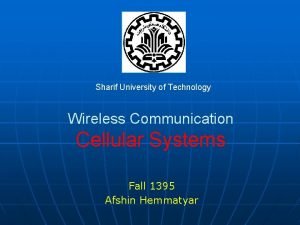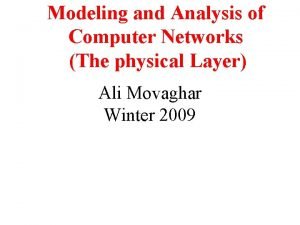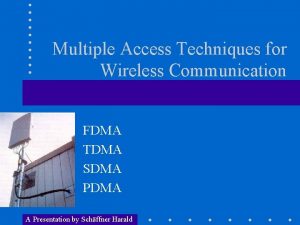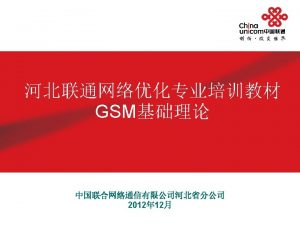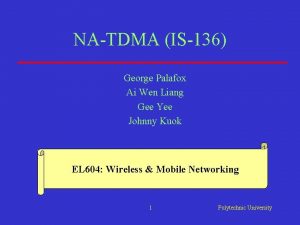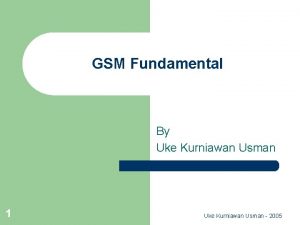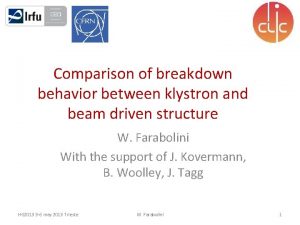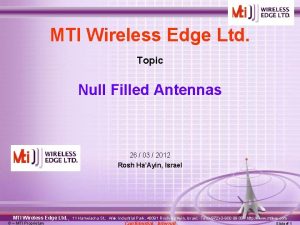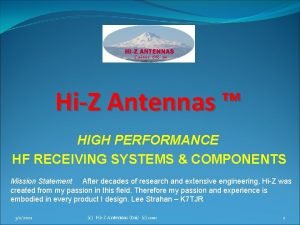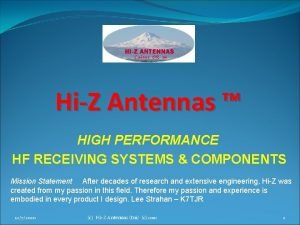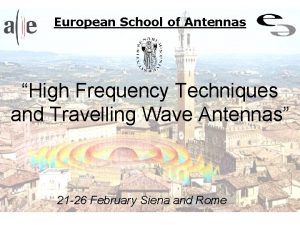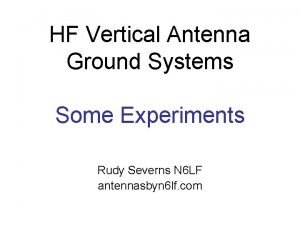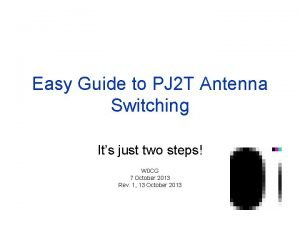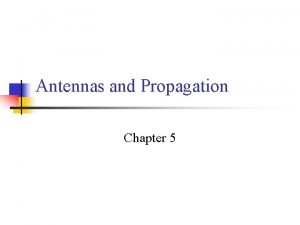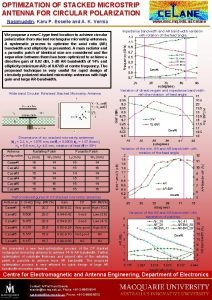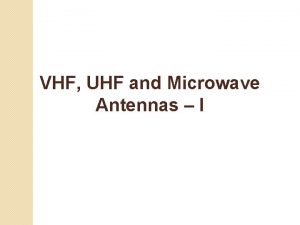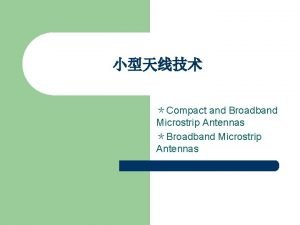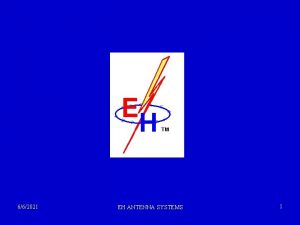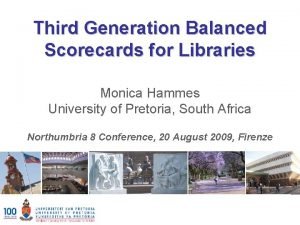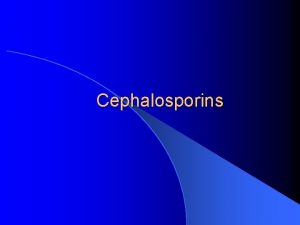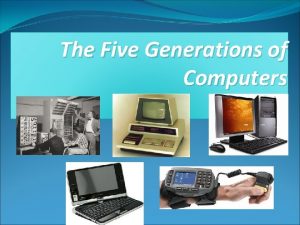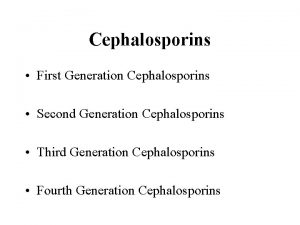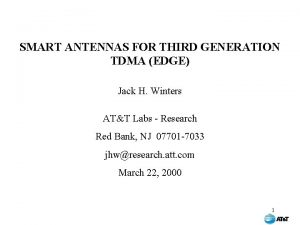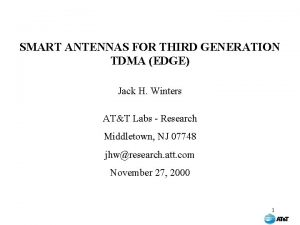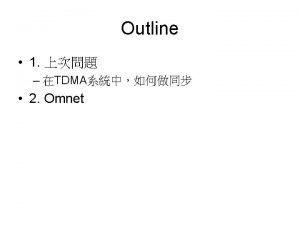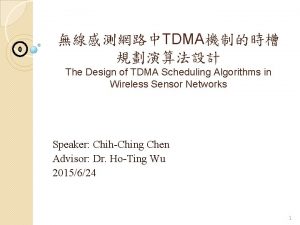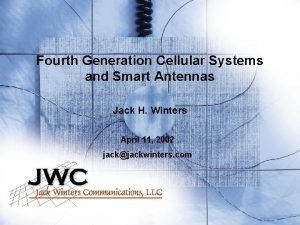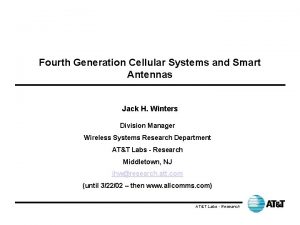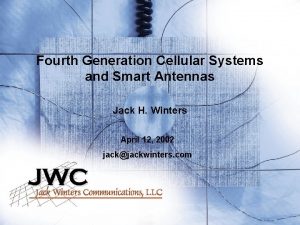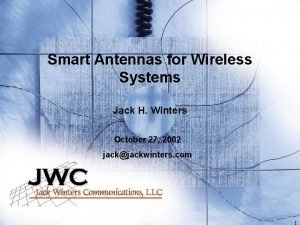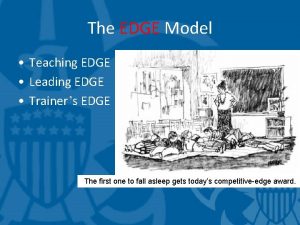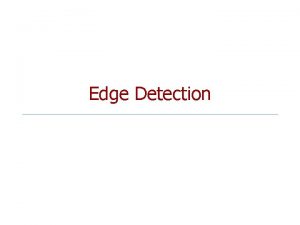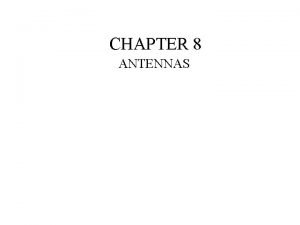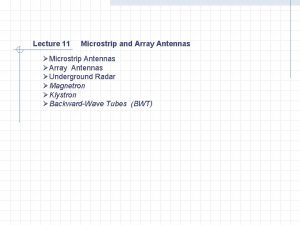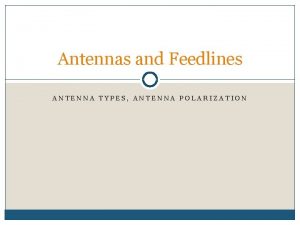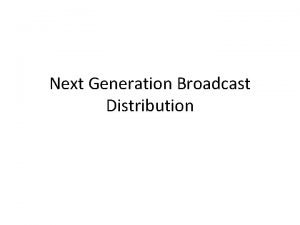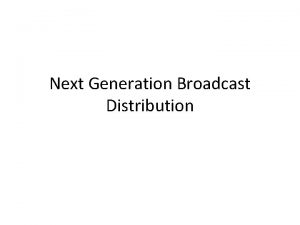SMART ANTENNAS FOR THIRD GENERATION TDMA EDGE Jack










![EQUALIZATION • Delay spread: Delay spread over [(M-1) / 2]T or M-1 delayed signals EQUALIZATION • Delay spread: Delay spread over [(M-1) / 2]T or M-1 delayed signals](https://slidetodoc.com/presentation_image_h/2e80ed09d51991987ff8ba67aa743fa8/image-11.jpg)















- Slides: 26

SMART ANTENNAS FOR THIRD GENERATION TDMA (EDGE) Jack H. Winters AT&T Labs - Research Red Bank, NJ 07701 -7033 jhw@research. att. com October 3, 2000 1

OUTLINE • Smart Antenna Overview • 2 G System Applications • 3 G System Applications: – EDGE – MIMO-EDGE – OFDM-MIMO-EDGE • Conclusions 2

WIRELESS SYSTEM IMPAIRMENTS Wireless communication systems are limited in performance and capacity by: Delay Spread Limited Spectrum Co. Channel Interference Rayleigh Fading 3

SMART ANTENNAS Today: Cellular systems with sectorization (120°) handoffs between sectors f 3 f 1 f 4 f 5 f 6 f 2 For higher performance Narrower sectors Too many handoffs Smart Antenna definition: Multibeam antenna or adaptive array without handoffs between beams 4

Smart Antennas Switched Multibeam Antenna Adaptive Antenna Array SIGNAL BEAMFORMER SIGNAL BEAM SELECT SIGNAL OUTPUT INTERFERENCE BEAMFORMER WEIGHTS Smart Antennas can significantly improve the performance of wireless systems • Higher antenna gain / diversity gain Range extension and multipath mitigation • Interference suppression Quality and capacity improvement • Suppression of delayed signals Equalization of ISI for higher data rates • Multiple signals in the same bandwidth Higher data rates Switched Multibeam versus Adaptive Array Antenna: Simple beam tracking, but limited interference suppression and diversity gain 5

BASE STATION DIVERSITY OPTIONS (4 ANTENNAS) 24 (12 ft) Spatial Diversity 3 (1. 5 ft) Angle Diversity 3 or 24 Polarization Diversity 6

Smart Antennas 11. 3 ft Rooftop Base Station Antennas Prototype Dual Antenna Handset Prototype Smart Antenna for Laptops 7

INTERFERENCE NULLING Line-Of-Sight Systems User 1 • • • User 1 Signal User 2 Utilizes spatial dimension of radio environment to: • Maximize signal-to-interference-plus-noise ratio • Increase gain towards desired signal • Null interference: M-1 interferers with M antennas 8

INTERFERENCE NULLING Multipath Systems User 1 • • • User 1 Signal User 2 Antenna pattern is meaningless, but performance is based on the number of signals, not number of paths (without delay spread). => A receiver using adaptive array combining with M antennas and N-1 interferers can have the same performance as a receiver with M-N+1 antennas and no interference, i. e. , can null N-1 interferers with M-N+1 diversity 9 improvement (N-fold capacity increase).

MIMO CAPACITY INCREASE • With M antennas at both the base station and mobiles, M independent channels can be provided in the same bandwidth if the multipath environment is rich enough. • 1. 2 Mbps in a 30 k. Hz bandwidth using 8 transmit and 12 receive antennas demonstrated by Lucent (indoors). • Separation of signals from two closely-spaced antennas 5 miles from the base station demonstrated by AT&T/Lucent. 10
![EQUALIZATION Delay spread Delay spread over M1 2T or M1 delayed signals EQUALIZATION • Delay spread: Delay spread over [(M-1) / 2]T or M-1 delayed signals](https://slidetodoc.com/presentation_image_h/2e80ed09d51991987ff8ba67aa743fa8/image-11.jpg)
EQUALIZATION • Delay spread: Delay spread over [(M-1) / 2]T or M-1 delayed signals (over any delay) can be eliminated • Typically use temporal processing with spatial processing for equalization: LE MLSE/DFE LE 11

SMART ANTENNAS IN SECOND GENERATION SYSTEMS • IS-136 TDMA: – On uplink, with two receive antennas, in 1999 changed from maximal ratio combining to MMSE combining • Software change only - provided 3 -4 d. B gain in interference-limited environments • Combined with power control on downlink (software change only) - increased capacity through frequency reuse reduction 12

SMART ANTENNAS IN SECOND GENERATION SYSTEMS • Techniques proposed a decade before implementation, but: – MMSE combining: SMI degrades performance when interference is not present • Solution: Diagonal loading with beta=f(I/N) – Power control: 1 second reporting delay of mobile BER and RSSI – unstable at pedestrian speeds • Solution: Use uplink RSSI (diversity) with mobile BER 13

SMART ANTENNAS IN SECOND GENERATION SYSTEMS • IS-136 TDMA: – On uplink, with two receive antennas, in 1999 changed from maximal ratio combining to MMSE combining • Software change only - provided 3 -4 d. B gain in interferencelimited environments • Combined with power control on downlink (software change only) - increased capacity through frequency reuse reduction – Use of 4 antennas (adaptive array uplink/multibeam, with power control, downlink) extends range and/or doubles capacity (N=7 to 4 or 3) • Clears spectrum for EDGE deployment (2001) 14

IS-136 Smart Antenna System • 4 Branch adaptive antenna uplink for range extension and interference suppression • Fixed switched beam downlink with power control for increased coverage and capacity • Uplink and downlink are independent • Shared linear power amplifiers reduce amplifier requirements to handle maximum traffic load RADIO UNIT ADAPTIVE ANTENNA RECEIVER 4 Branches DUPLEXERS Power Control Atten RSSI, BER SPLITTER Shared LPAs TRANSMITTER • BEAM SCANNING RECEIVER 1 per N radios 15

SMART ANTENNAS IN THIRD GENERATION SYSTEMS: EDGE • High data rate ( 384 kbps) service based on GSM, for both Europe and North America • 8 PSK at 270. 833 ksps • 26 symbol training sequence • 1/3, 3/9 or 4/12 reuse 3 58 26 58 3 8. 25 576. 92 s 16

ADAPTIVE ARRAYS IN EDGE Spatial-Temporal processing using DDFSE for interference suppression 17

ADAPTIVE ARRAYS IN EDGE 18

EDGE Smart Antenna Processing Dual Diversity Receiver Using Delayed Decision Feedback Sequence Estimator for Joint Intersymbol Interference and Co-channel Interference Suppression EDGE with Interference Suppression in a Typical Urban Environment Rx Channel Decoder Output Data Rx Block Error Rate DDFSE Equalizer Signal -to-Interference Ratio (d. B) • • Real-time EDGE Test Bed supports laboratory and field link level tests to demonstrate improved performance Simulation results show a 15 to 30 d. B improvement in S/I with 2 receive antennas 19 Wireless Systems Research

Multiple-Input Multiple-Output (MIMO) Techniques for 3 G Wireless Systems • • • Multiple antennas at both the base station and terminal can significantly increase data rates if the multipath environment is rich enough sufficient multipath low correlation high spectral efficiency With 4 transmit and receive antennas 4 independent data channels can be provided in the same bandwidth Data rates as high as 1. 5 Mbps (4 x 384 kbps) may be possible for EDGE or 20 as high as 40 Mbps for Wideband OFDM (also can be used in WCDMA/HDR)

MIMO-EDGE • Goal: 4 transmit / 4 receive antennas in EDGE can theoretically increase capacity 4 -fold with the same total transmit power (3. 77 X 384 kbps = 1. 45 Mbps is actual theoretical increase) • Issues: – Joint spatial-temporal equalization – Weight adaptation – Mobile channel characteristics to support MIMO-EDGE • Our approach: – Development of multi-antenna EDGE testbed – Development of 2 X 2 and 4 X 4 DDFSE architecture with MMSE combining using successive interference cancellation – Mobile channel measurements 21

MIMO Channel Testing Mobile Transmitter W 1 Tx W 2 Tx W 3 Tx W 4 Synchronous test sequences Tx LO Test Bed Receiver with Rooftop Antennas Transmit Antenna Configurations Rx • Record complex correlation of each transmit waveform on each receive antenna, C 4 x 4 Rx • Compute CHC correlation matrix to determine potential capacity and predict performance Rx Space diversity Space / polarization diversity • Compute fading correlation across receive array Rx LO Space / pattern diversity Space / polarization / pattern diversity 22

MIMO Channel Measurement System Transmitter • 4 antennas mounted on a laptop • 4 coherent 1 Watt 1900 MHz transmitters with synchronous waveform generator Receive System • Dual-polarized slant 45° PCS antennas separated by 10 feet and fixed multibeam antenna with 4 - 30° beams • 4 coherent 1900 MHz receivers with real-time baseband processing using 4 TI TMS 320 C 40 DSPs 23

24

EDGE with Wideband OFDM MIMO Downlink • High data rates (>1 Mbps) required on downlink only • OFDM eliminates need for temporal processing => simplified MIMO processing for much higher data rates • With 1. 25 MHz bandwidth, QPSK, OFDMMIMO with 4 antennas at base station and terminal => 10 Mbps downlink 25

SMART ANTENNA EVOLUTION FOR TDMA • IS-136: • Optimum combining uplink / power control downlink at all base stations with existing 2 Rx/1 Tx antennas • 4 Rx/4 Tx antenna upgrade (adaptive uplink/multibeam downlink) for N=7 to 4 to clear spectrum for EDGE • EDGE: • S-T processing with IS-136 smart antennas (Data followed by Vo. IP) • MIMO-EDGE (1. 5 – 2. 4 Mbps) • Wideband OFDM-MIMO downlink (10 - 40 Mbps) • 4 Rx/4 Tx base station with software radio for software evolution at base station with terminal replacements • Research issues: Deployment strategies / integration with DCA, PC, adaptive modulation and coding / improved weight adaptation with CCI 26
 Truncing
Truncing Draw tdma frame structure of gsm
Draw tdma frame structure of gsm Tdma
Tdma Gsm tdma
Gsm tdma Na-tdma
Na-tdma Uke kurniawan
Uke kurniawan Main characters of jack and the beanstalk
Main characters of jack and the beanstalk Rising edge and falling edge
Rising edge and falling edge (“mti wireless edge” or mtiwe) and anten
(“mti wireless edge” or mtiwe) and anten K7tjr
K7tjr Hi-z antennas
Hi-z antennas European school of antennas
European school of antennas Stacking yagi antennas
Stacking yagi antennas N6lf radials
N6lf radials Hi-q antennas
Hi-q antennas Bencher skyhawk
Bencher skyhawk Antennas and propagation
Antennas and propagation Nasimuddin+microstrip+antennas
Nasimuddin+microstrip+antennas Vhf uhf and microwave antennas
Vhf uhf and microwave antennas Broadband microstrip antennas
Broadband microstrip antennas Eh antenna
Eh antenna First generation antipsychotics
First generation antipsychotics Lord you are good and your mercy is forever
Lord you are good and your mercy is forever Third generation balanced scorecard
Third generation balanced scorecard Third and fourth generation cephalosporins
Third and fourth generation cephalosporins Five generation of computer
Five generation of computer Pharmoco
Pharmoco
